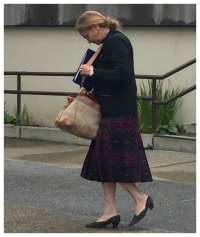IS ALICE ROGOFF NOW THE WEALTHIEST PERSON IN ALASKA?
Timing is everything. Two events happened this week in the life and times of Alice Rogoff, the once-publisher of the former Alaska Dispatch News.
They relate.
Rogoff and David Rubenstein are divorced. That became official on Friday.
Meanwhile, in bankruptcy court in Anchorage, lawyers filed arguments about whether Rogoff’s personal finances should be examined.
The Trustee appointed by the court wants to see if Rogoff was running the Dispatch out of her own personal bank accounts, mixing business and personal finances to the extent that her personal checkbook should be included when a settlement is reached with all of the Dispatch’s hundreds of creditors to whom she owes millions of dollars.
Among those creditors is her former business partner Tony Hopfinger, who says she has stiffed him for at least $900,000. That case is pending, but others, such as Northrim Bank and even her former employees, are hoping they get made whole before that goes to trial in March.
Rogoff claims she, too, is a creditor of the Dispatch. And she wants to be paid first.
But the settlement in her divorce from Rubenstein is a new twist. With his net worth estimated to be about $2.8 billion, it could be worth hundreds of millions of dollars. No one knows, and she likes it that way.
Creditors are likely to fight hard to find out. Rogoff has added more lawyers to her team to prevent that.
Since 1983, Rogoff had been married to Rubenstein, the billionaire hedge fund founder of the Carlyle Group who is also a flashy philanthropist and one of the world’s richest men.
The couple has been apart for over a decade, and the divorce was granted in Montgomery County, Maryland, where the couple had a lovely 9,600-square-foot home valued at $3.42 million, with a guesthouse next to it.
The financial terms of the divorce are private, according to the lawyers of the divorcing parties.
The Washington Post printed a joint statement from the once-feted Washington power couple: “Alice and David Rubenstein have decided to formalize a divorce following a lengthy separation. The parties continue in support of one another and their respective endeavors. They are and continue to be devoted parents and their love and respect for their family is most important to each of them. They wish each other nothing but the best.”
REWIND
Rogoff came to Alaska in 2002 and became an influential person almost immediately, a champion for the arts, Native culture, progressive causes, and enjoyed celebrity status as the darling of the liberal elite.
Alaska is a state where a person like her, with money, connections, and panache, can make a big splash. Others have seen the same opportunity in Alaska, and some have succeeded, while others crashed spectacularly as a result of their own hubris.
Rogoff opened The Alaska House in Manhattan, and an art gallery in downtown Anchorage. The Alaska House closed, unable to pay its bills without getting $600,000 in state money that she requested from the Legislature. The Anchorage art gallery also folded after the Parnell Administration cut the spigot of state money.
The shell foundation she created to launch the Anchorage gallery gave the remaining art to the Sealaska Heritage Foundation, but no paper trail has ever been produced for the transfer. It was another State boondoggle, although a small one compared to the Delta Barley Project, for example.
Rogoff purchased majority ownership in the Alaska Dispatch News and eventually the Anchorage Daily News and combined the two, and became a part of Gov. Bill Walker’s inner circle, using her influence through the Dispatch to ensure his election in 2014.
She became a member of his “kitchen cabinet,” a business roundtable group he convened regularly. As one of that group of business leaders, she encouraged the governor to leverage the Permanent Fund by using it to borrow money in order to pay state bills. She editorialized on April 11, 2015 about using this method of funding state government:
“Borrowing against that wealth at favorable terms, we could sustain a reasonable economy with quality state services in education, public safety and sound development. In short, there’s no reason to suffer. We are still wealthy. We just need to leverage our wealth,” she wrote.
“There’s nothing radical about this. Think of it as the home-mortgage concept many of us use in our personal lives.
“We get 30-year mortgages for our homes and repay them slowly, building up equity over many years. That way, we can use the rest of our income to achieve what we think is most important — investing in our children and our own futures. We take out student loans that we repay when we have steady employment. Car loans and credit cards allow us make purchases that we finance over time. For most of us, well-managed debt is a handy tool to improve our circumstances. It frees us from being held back in our lives by providing us “cash flow” when we need it.”
Rogoff was advising the governor she ushered into office to borrow against the Permanent Fund. Borrowing is what she was doing to finance her lifestyle and newspaper ambitions.
In August of 2015, she hosted President Barack Obama at her Anchorage home. In 2016, she crashed her airplane into Halibut Cove while on the way to visit former Sen. Clem Tillion and attend the wedding of former Lt. Gov. Mead Treadwell. Pilots said it was a miracle she was able to swim away from the crash.

In the summer of 2017, Rogoff filed for Chapter 11 bankruptcy, sold her newspaper to the Binkley Company, and later this year saw her remaining entity, the defunct limited liability company, go into Chapter 7, which is when the court decides there is no way to repair the finances of the bankrupt entity.
LATEST IN BANKRUPTCY
Earlier this month, Rogoff’s lawyers objected to a section “2004” bankruptcy hearing in which her personal finances would be examined. Rogoff’s lawyers wrote they fear it would lead to her being personally liable for her debts.
But the lawyer for the Bankruptcy Trustee responded to the court on Dec. 5: “That concern does not form the basis of a legitimate objection to the Trustee’s request, actually obligation, to examine the Debtor nor does it provide any basis to limit the scope of the examination.”
The next bankruptcy hearing for Rogoff will be Dec. 15, when the judge will decide whether her personal finances — now possibly with million of more dollars at stake — can be examined.

















